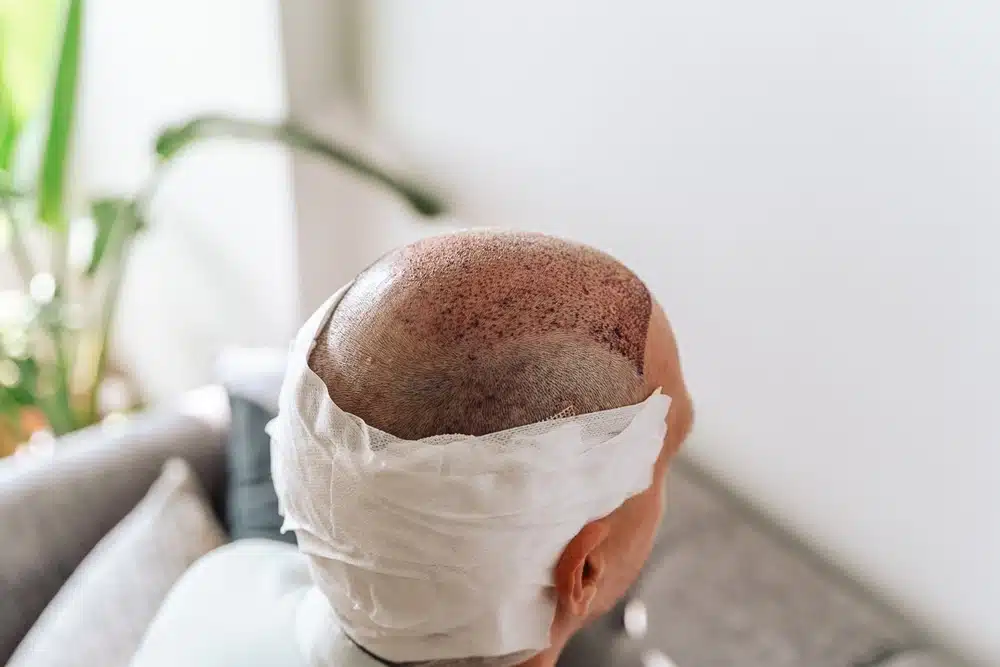Proper post-operative care is crucial for achieving the best possible results after a hair transplant. While the procedure itself is a major milestone in restoring hair growth, the care you provide for your hair in the weeks and months that follow can greatly impact the outcome. Taking the time to properly care for your scalp and transplanted hair can help ensure that your results are natural-looking and long-lasting.
In this article, we’ll cover everything you need to know about caring for your hair after a transplant. From immediate post-operative care to long-term maintenance, we’ll provide you with step-by-step instructions and tips to help you achieve optimal results. Whether you’re a first-time transplant patient or a seasoned pro, this guide will provide you with the information you need to take care of your newly transplanted hair.
At the Harley Street Hair Clinic, we provide personalised hair transplant aftercare to each patient depending on a number of factors, for those in early research stages we’ve provided a rough outline of what you can expect post-transplant.
Immediate Post-Operative Care
After your hair transplant procedure, your scalp will be in a sensitive state and require special care to ensure proper healing. It is important to follow your surgeon’s instructions carefully to avoid any complications and achieve optimal results.
Immediately after the procedure, you can expect some swelling, tenderness, and possibly even some mild bleeding in the donor and recipient areas. This is normal and should subside within a few days. Your surgeon may provide you with pain medication or antibiotics to manage any discomfort and prevent infection.
One of the most important aspects of immediate post-operative care is cleaning and caring for the recipient area. Your surgeon will likely provide you with a special shampoo to use during the first week or two after the procedure. It is important to gently wash your scalp using this shampoo, being careful not to rub or scratch the grafts. This will help prevent infection and promote proper healing.
It is also important to avoid any physical activities that may harm the grafts during the immediate post-operative period. This includes any heavy lifting, bending over, or activities that cause excessive sweating.
It is recommended to sleep with your head elevated for the first few days after the transplant. This will help reduce swelling and prevent any unintentional rubbing or movement of the grafts. You may also be advised to sleep on your back to avoid putting pressure on the grafts.
By following these instructions and taking care of your scalp during the immediate post-operative period, you can help ensure the best possible outcome for your hair transplant. Remember to be patient and gentle with your scalp as it heals, and don’t hesitate to contact us if you have any questions or concerns.
First-week post-transplant
The first week after a hair transplant is a critical period for proper healing and the initial stages of hair growth. It’s important to continue providing diligent care to your scalp during this time. Here are some key points to consider for the first week after your transplant;
- Maintaining proper hygiene: During the first week, it’s crucial to keep the recipient area clean to prevent infection and promote healing. Your surgeon may provide specific instructions on how to wash your scalp. It typically involves using a gentle touch and avoiding any rubbing or scratching of the grafts. Be sure to follow their guidance and use the recommended shampoo or cleanser
- Avoiding direct sunlight and extreme weather conditions: Protecting your scalp from direct sunlight and extreme weather conditions is essential during the first week after the transplant. Exposure to excessive heat, cold, or sunlight can harm the healing grafts and affect their survival. If you need to go outdoors, wear a hat.
- Limiting physical activities, during the first week, it’s crucial to avoid any activities that may put strain on the scalp or cause excessive sweating. This includes rigorous exercises, heavy lifting, and intense workouts. Sweating can increase the risk of infection and dislodge the grafts. It’s best to follow your surgeon’s instructions regarding physical activity limitations and gradually resume normal activities as advised.
- Monitoring for signs of infection or complications: While rare, it’s important to be vigilant for any signs of infection or complications during the first week after the transplant. Keep an eye out for increased redness, swelling, persistent pain, pus, or drainage from the grafts or donor area. If you notice any concerning symptoms, contact your surgeon immediately for further evaluation and guidance.
- Remember, each individual’s healing process may vary, so it’s important to follow your surgeon’s specific post-operative instructions. By diligently caring for your scalp during the first week, you can support proper healing and contribute to the success of your hair transplant.
Weeks 2-4 post-transplant
As you progress into weeks 2-4 after your hair transplant, your scalp will continue to heal and adapt to the changes brought about by the procedure. During this period, it’s crucial to maintain gentle care and follow the guidelines provided by your surgeon. Here are some key aspects to consider for weeks 2-4 after your transplant.
- Gentle washing and drying: You should continue washing your scalp with the prescribed shampoo or cleanser as instructed by your surgeon. However, by this stage, you may be able to apply slightly more pressure during washing to remove any residual scabs or crusts. Gently massage the recipient area with your fingertips, ensuring not to disturb or dislodge the grafts. After washing, pat your scalp dry with a soft towel or use a hairdryer on the cool setting to avoid any excessive heat or friction.
- Gradual resumption of normal activities: You can gradually resume normal activities, including light exercises and workouts. However, still avoid any activities that involve direct contact with the scalp or may cause excessive sweating. It’s essential to strike a balance between resuming your routine and ensuring you don’t compromise the healing process.
- Avoiding exposure to direct sunlight: Protecting your scalp from direct sunlight remains crucial during weeks 2-4 and beyond. Ultraviolet (UV) radiation can harm the healing grafts and contribute to inflammation. Wear a hat or use broad-spectrum sunscreen with a high SPF when you are outdoors, especially during peak sun hours.
- Be patient with the shedding phase: It’s common to experience shedding of the transplanted hair during weeks 2-4. This is a normal part of the hair growth cycle, and new hair will begin to grow in its place in the coming months. Avoid excessive worrying or anxiety during this period, as it’s an expected and temporary phase in the hair restoration process.
Long-Term Care
After the first couple of months post-hair transplant your aftercare beings to stop, you should be almost healed by this point and simply waiting for your results to show. There are, however, a few points to consider;
- Follow-up appointments: Ensure you attend your follow-up appointments with your surgeon, these are crucial for monitoring the progress of your hair transplant and addressing any concerns.
- Patience and realistic expectations: Remember that hair growth takes time. It’s important to be patient and have realistic expectations regarding the outcome of your hair transplant. Hair regrowth varies among individuals, and it may take several months before you start noticing significant improvements. Understanding the natural hair growth cycle and the gradual progression of results will help you stay positive throughout the process.
If you have any questions about hair transplantation or aftercare, you can download our app and talk directly with one of our consultants.


